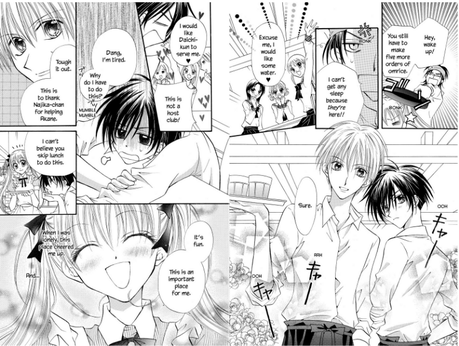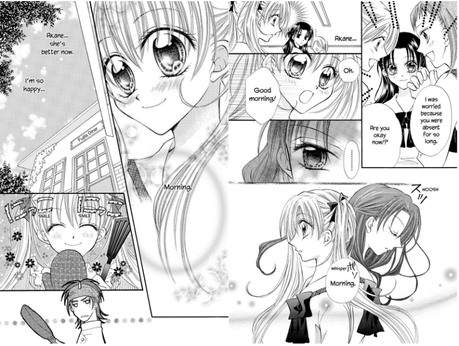If
Fruits Basket is what people think of when they think “shoujo manga” then
Kitchen Princess will seem like a familiar title as well. Despite coming out slightly later —
Fruits Basket ended in 2006 while this ended in 2008 — there’s a huge overlap in art styles, tropes, and even character types, even if
KP ultimately skews a bit younger in age.
Najika Kazami comes into our story as a cheerful, orphaned country bumpkin who is leaving behind her childhood home in order to study at a Tokyo school filled with famous and talented students. She hopes that her infectious cheeriness can win over her classmates. She also has another reason for attending Seika Academy: Years ago she was rescued by a boy she nicknamed her “Flan Prince.” The only connection she has to him is a spoon from the same school, but it’s proven difficult to learn just who he is with so few details. Like any high-class school worth its salt, Najika’s classmates are petty, fickle people. Even the people who are nice to her seem to either have an ulterior motive or aren’t actually that nice, and there’s a lot of negativity to keep her down. But Najika’s cooking is her connection to her family and it will take a lot to make her forget that.
 KP
KP, like the sweets Najika loves to make, is full of sugar and fluff and in many ways its tone reminds me more of “classical” or “old fashioned” shoujo more than current series. The plots and conflicts would fit into any decade; it seems as if Najika can save any baking related problem by pitching in and working harder than anyone else. While Najika does snap back at her classmates sometimes it’s always because of bullying — there’s never any casual quipping or snarking. While there are times that Najika loses her seemingly relentless optimism, she tends to flip over to an almost catatonic state; she is either at the top of her game and in love with the world or she has no interest in living at all. And, like all shoujo titles, there is plenty of tragedy to induce these moods! Her life is marked by periods of loss and loneliness — a big reason why she reaches out to other people so much. My favorite part of the series is how Akane’s subplot is handled actually, she’s fulfills the whole “shoujo rival” archetype to a T but there are deeper issues lurking underneath. The story manages to pace out the resolution perfectly instead of hurrying her back off stage as Najika’s life takes more unexpected turns.

The art style is another part of the series that looks unmistakably shoujo. The cast have tall eyes, short, round faces, and at least half of each page is covered in screentones. The cast unfortunately looks a bit too similar at times, but all of the food is lovingly drawn and yes, the series provides copious recipes both within the text and as extras (along with quite a few notes from the author on the cover pages, I miss seeing those!). I do think that the focus on food is what helps this series stand out, as it helps give the story more focus than many school romances. While there is certainly plenty of love triangle antics in the story, Najika is always very focused on her cooking and wanting to become better, not famous for it. Giving her a personal goal is a clever idea and it actually sets her (and Akane) apart from Sora and Daichi when usually it’s the other way around! These cooking competitions keep the pace moving without too much padding and it feels like a seamless collaboration between writer Miyuki Kobayashi and artist Natsumi Ando. Ultimately it’s a sweet story, one that’s safe for a real middle-schooler to read, with some good messages and an honest, loving tone to it.
Missed it? Kitchen Princess was formerly licensed by Del Rey Manga and has since been re-issued in omnibus form by Kodansha Comics USA.
 KP, like the sweets Najika loves to make, is full of sugar and fluff and in many ways its tone reminds me more of “classical” or “old fashioned” shoujo more than current series. The plots and conflicts would fit into any decade; it seems as if Najika can save any baking related problem by pitching in and working harder than anyone else. While Najika does snap back at her classmates sometimes it’s always because of bullying — there’s never any casual quipping or snarking. While there are times that Najika loses her seemingly relentless optimism, she tends to flip over to an almost catatonic state; she is either at the top of her game and in love with the world or she has no interest in living at all. And, like all shoujo titles, there is plenty of tragedy to induce these moods! Her life is marked by periods of loss and loneliness — a big reason why she reaches out to other people so much. My favorite part of the series is how Akane’s subplot is handled actually, she’s fulfills the whole “shoujo rival” archetype to a T but there are deeper issues lurking underneath. The story manages to pace out the resolution perfectly instead of hurrying her back off stage as Najika’s life takes more unexpected turns.
KP, like the sweets Najika loves to make, is full of sugar and fluff and in many ways its tone reminds me more of “classical” or “old fashioned” shoujo more than current series. The plots and conflicts would fit into any decade; it seems as if Najika can save any baking related problem by pitching in and working harder than anyone else. While Najika does snap back at her classmates sometimes it’s always because of bullying — there’s never any casual quipping or snarking. While there are times that Najika loses her seemingly relentless optimism, she tends to flip over to an almost catatonic state; she is either at the top of her game and in love with the world or she has no interest in living at all. And, like all shoujo titles, there is plenty of tragedy to induce these moods! Her life is marked by periods of loss and loneliness — a big reason why she reaches out to other people so much. My favorite part of the series is how Akane’s subplot is handled actually, she’s fulfills the whole “shoujo rival” archetype to a T but there are deeper issues lurking underneath. The story manages to pace out the resolution perfectly instead of hurrying her back off stage as Najika’s life takes more unexpected turns.
 The art style is another part of the series that looks unmistakably shoujo. The cast have tall eyes, short, round faces, and at least half of each page is covered in screentones. The cast unfortunately looks a bit too similar at times, but all of the food is lovingly drawn and yes, the series provides copious recipes both within the text and as extras (along with quite a few notes from the author on the cover pages, I miss seeing those!). I do think that the focus on food is what helps this series stand out, as it helps give the story more focus than many school romances. While there is certainly plenty of love triangle antics in the story, Najika is always very focused on her cooking and wanting to become better, not famous for it. Giving her a personal goal is a clever idea and it actually sets her (and Akane) apart from Sora and Daichi when usually it’s the other way around! These cooking competitions keep the pace moving without too much padding and it feels like a seamless collaboration between writer Miyuki Kobayashi and artist Natsumi Ando. Ultimately it’s a sweet story, one that’s safe for a real middle-schooler to read, with some good messages and an honest, loving tone to it.
Missed it? Kitchen Princess was formerly licensed by Del Rey Manga and has since been re-issued in omnibus form by Kodansha Comics USA.
The art style is another part of the series that looks unmistakably shoujo. The cast have tall eyes, short, round faces, and at least half of each page is covered in screentones. The cast unfortunately looks a bit too similar at times, but all of the food is lovingly drawn and yes, the series provides copious recipes both within the text and as extras (along with quite a few notes from the author on the cover pages, I miss seeing those!). I do think that the focus on food is what helps this series stand out, as it helps give the story more focus than many school romances. While there is certainly plenty of love triangle antics in the story, Najika is always very focused on her cooking and wanting to become better, not famous for it. Giving her a personal goal is a clever idea and it actually sets her (and Akane) apart from Sora and Daichi when usually it’s the other way around! These cooking competitions keep the pace moving without too much padding and it feels like a seamless collaboration between writer Miyuki Kobayashi and artist Natsumi Ando. Ultimately it’s a sweet story, one that’s safe for a real middle-schooler to read, with some good messages and an honest, loving tone to it.
Missed it? Kitchen Princess was formerly licensed by Del Rey Manga and has since been re-issued in omnibus form by Kodansha Comics USA.

